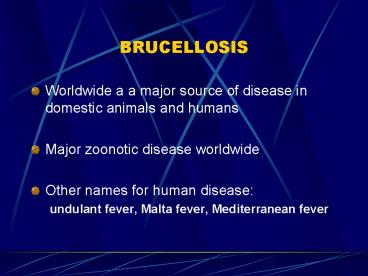BRUCELLOSIS - PowerPoint PPT Presentation
1 / 22
Title:
BRUCELLOSIS
Description:
Weight loss. BRUCELLOSIS. Disease in humans. Duration: days to months; year if untreated ... in acute phase; lysis concentration method yields best results ... – PowerPoint PPT presentation
Number of Views:686
Avg rating:3.0/5.0
Title: BRUCELLOSIS
1
BRUCELLOSIS
- Worldwide a a major source of disease in domestic
animals and humans - Major zoonotic disease worldwide
- Other names for human disease
- undulant fever, Malta fever, Mediterranean fever
2
BRUCELLOSIS
- 1861 British army physician (Marston) published
description of Mediterranean gastric remittent
fever - 1886 Isolated by Sir David Bruce from soldier
with Malta Fever named it Micrococcus
mellitensus - 1897 Bernard Bang, Danish veterinarian/physician
, first isolated B. abortus from cattle - Relationship of both isolates recognized by Alice
Evans renamed Brucella in honor of Bruce
3
BRUCELLOSIS
4
BRUCELLOSIS
- Microbiology
- Gram negative coccobacilli
- Non-spore forming
- Lack capsules
- Non-motile (no flagella)
- Metabolism
- primarily oxidative
- aerobic to microaerophillic (5-10 CO2)
- slow growth _at_ 37C on enriched medium
5
BRUCELLOSIS
- Microbiology
- Classification
- Species level based on colony morphology (rough
or smooth), serum requirement, phage lysis, and
biochemical reactions (oxidase and urease) - Antigenic (biovar) classification
- For smooth specits, O chains in the LPS
(lipopolysaccharide) called A and M - cross-react with other smooth species but not
with rough
6
BRUCELLOSIS
- Microbiology
Impression smear of B. abortus from aborted fetus
7
BRUCELLOSIS
- Microbiology
Impression smear of B. suis from aborted tissue
8
BRUCELLOSIS
- Pathogenecity
- Infection of non-phagocytic cells
- Mechanism of invasion not clearly understood
- Localize in rough endoplasmic reticulum
- Infection of phagocytic cells
- Invasion of PMN or MN cellsby suppression of
bactericidal responses - S-LPS (smooth) plays major roll in intracellular
survival survive more effectively than rough - low toxicity for macrophages
- low pyrogenecity
9
BRUCELLOSIS
- Pathogenecity
- Virulence
- Elimination of virulent organisms depends on
activated macrophages and development of Th1
cell-mediated response to antigens - Determinants
- S-LPS is main antigen responsible for protection
- Inhibition of phagolysosome fusion
- Activation of myelo-peroxidase-halide system
- Production of tumor necrosis factor
10
BRUCELLOSIS
- Epidemiology
- Occurrence worldwide, particularly
Mediterranean, Africa, Middle East, Latin America - Incidence
- True incidence unknown due to underreporting
- Endemic areas gt200/100,000
- U.S. lt1/100,000
- 200 cases per year
- majority of cases from Texas, California,
Virginia, Florida
11
BRUCELLOSIS
- Epidemiology
- Transmission
- Direct contact
- With tissues (vaginal discharge, blood, urine,
aborted fetus) - Ingestion
- Raw milk, milk products
- Innoculation
- Strain-19 or Rev-1 vaccine
12
BRUCELLOSIS
Epidemiology transmission
13
BRUCELLOSIS
- Disease in animals
- Primary hosts generally highly susceptible
- Varying degrees of resistance in secondary and
aberrant hosts
14
BRUCELLOSIS
15
BRUCELLOSIS
16
BRUCELLOSIS
- Disease in humans
- Incubation period 30-60 days ( or longer)
- Signs and symptoms
- Acute or insidious onset of intermittent fever
- Accompanied by one of more of the following
- Headache
- Weakness
- Profuse sweating
- Arthralgia
- Depression
- Weight loss
17
BRUCELLOSIS
- Disease in humans
- Duration
- days to months gt year if untreated
- Complications
- osteoarticular complications (up to 60 of cases)
- genitourinary up to 20 of cases) most commonly
orchitis and epididymitis - Case Fatality Ratio lt2
- usually due to cardiac complications
(endocarditis)
18
BRUCELLOSIS
- Disease in humans
- Diagnosis
- Blood culture effective in acute phase lysis
concentration method yields best results - allowance for slow growth
- confirmation by phage typing, oxidative
metabolism, or genotyping - Enzyme immunoassay (EIA, ELISA)
- IgA and IgG antibodies indication of active
infection - PCR antigen detection methods useful but not
validated particularly useful for chronic disease
19
BRUCELLOSIS
- Disease in humans
- Treatment
- WHO regimen rifampin (600-900mg) and
doxycycline (200mg) daily for at least 6 weeks - more advanced cases require addition of an
aminoglycoside - Rifampin treatment of choice for children,
followed by cotrimoxazole
20
BRUCELLOSIS
- Prevention
- Ultimately rests upon elimination or control of
disease among domestic animals - Hygienic measures
- Pasteurization
- Avoid ingestion of unpasteurized or untreated
milk products - Avoid direct contact with tissues from suspect
animals - Proper protective clothing by workers in
abattoirs and other livestock operations hunters - Immunization - small role in human population
21
BRUCELLOSIS
- Eradication efforts U.S.
- Cattle
- Currently 44 states are certified Free
- No infected herds in 12 consecutive months
- 6 are class A
- Texas, Louisiana, South Dakota, Florida,
Missouri, Oklahoma - Must have 12 consecutive months with no infected
herds to achieve Free certification - Methodtest and slaughter
- Sexually intact heifers at 4 months, bulls at 18
months
22
BRUCELLOSIS
- Eradication efforts U.S.
- Swine
- Currently 46 states are certified Free
- 4 are class A
- TX, LA, FL, AR
- Feral swine- problem with comingling
- Control program in Texas
- If trapped, must be tested prior to relocation or
taken to slaughter - Hunter safety education efforts
- Meat safe if thoroughly cooked































